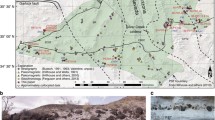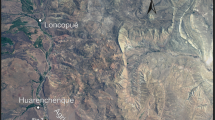Abstract
Pyroclastic deposits from the 1883 eruption of Krakatau are described from areas northeast of the volcano on the islands of Sebesi, Sebuku, and Lagoendi, and the southeast coast of Sumatra. Massive and poorly stratified units formed predominantly from pyroclastic flows and surges that traveled over the sea for distances up to 80 km. Granulometric and lithologic characteristics of the deposits indicate that they represent the complement of proximal subaerial and submarine pyroclastic flow deposits laid down on and close to the Krakatau islands. The distal deposits exhibit a decrease in sorting coefficient, median grain size, and thickness with increasing distance from Krakatau. Crystal fractionation is consistent with the distal facies being derived from the upper part of gravitationally segregated pyroclastic flows in which the relative amount of crystal enrichment and abundance of dense lithic clasts diminished upwards. The deposits are correlated to a major pyroclastic flow phase that occurred on the morning of 27 August at approximately 10 a.m. Energetic flows spread out away from the volcano at speeds in excess of 100 km/h and traveled up to 80 km from source. The flows retained temperatures high enough to burn victims on the SW coast of Sumatra. Historical accounts from ships in the Sunda Straits constrain the area affected by the flows to a minimum of 4x103 km2. At the distal edge of this area the flows were relatively dilute and turbulent, yet carried enough material to deposit several tens of centimeters of tephra. The great mobility of the Krakatau flows from the 10 a.m. activity may be the result of enhanced runout over the sea. It is proposed that the generation of steam at the flow/seawater interface may have led to a reduction in the sedimentation of particles and consequently a delay in the time before the flows ceased lateral motion and became buoyantly convective. The buoyant distal edge of these ash-and steam-laden clouds lifted off into the atmosphere, leading to cooling, condensation, and mud rain.
Similar content being viewed by others
References
Barberi F, Innocenti F, Liser L, Munno R, Pescatore T, Santacroce R (1978) The Campanian ignimbrite: a major prehistoric eruption in the Neapolitan area. Bull Volcanol 41 (1):10–31
Baxter PJ (1990) Medical effects of volcanic eruptions I. Main causes of death and injury. Bull Volcanol 52:532–544
Birowo S, Uktolseja H (1983) Oceanographic features of Sunda Strait. In: Bird E, Soegiarto A, Soegiarto K (eds) Proceedings of Workshop on coastal resources management of Krakatau and the Sunda Strait region, Indonesia. Indones Instit Sci United Nation Univ, pp 54–75
Camus G, Vincent P (1983) Discussion of a new hypothesis for the Krakatau volcanic eruption in 1883. J Volcanol Geotherm Res 19:167–173
Carey SN, Sigurdsson H, Sparks RSJ (1988) The fluid dynamic behavior of particle-laden plumes. J Geophys Res 93:15314–15328
Cas R, Wright JV (1991) Subaqueous pyroclastic flows and ignimbrites: an assessment. Bull Volcanol 53:357–380
Dawson AG, Smith DE, Long D (1990) Evidence for a tsunami from a mesolithic site in Inverness, Scotland. J Archaeol Sci 17:509–512
Dawson AG, Foster I, Shi S, Smith DE, Long D (1991) The identification of tsunami deposits in coastal sediment sequences. Sci Tsunami Hazards 9:73–82
Druitt TH (1992) Emplacement of the 18 May 1980 lateral blast deposit ENE of Mount St. Helens, Washington. Bull Volcanol 54:554–572
Druitt TH, Sparks RSJ (1984) On the formation of calderas during ignimbrite formation. Nature 310:679–681
Fierstein J, Nathanson M (1992) Another look at the calculation of fallout tephra volumes. Bull Volcanol 54:156–167
Fisher RV (1990) Transport and deposition of a pyroclastic surge across an area of high relief: the 18 May 1980 eruption of Mount St. Helens. Geol Soc Am Bull 192:1038–1054
Folk RL (1968) Petrology of sedimentary rocks. Hamphill's, Austin, pp 1–70
Francis P (1985) The origin of the 1883 Krakatau tsunamis. J Volcanol Geotherm Res 25:349–364
Furneaux R (1964) Krakatau. Prentice-Hall, New Jersey, pp 1–224
Harjono H, Diament M, Dubois J, Lane M (1991) Seismicity of the Sunda Strait: evidence for crustal extension and volcanological implications. Tectonics 10 (1):17–30
Huchon P, LePichon X (1984) Sunda Strait and Central Sumatra Fault. Geology 12:668–672
Kieffer SW (1981) Fluid dynamics of the May 18 blast at Mount St. Helens. In: Lipman PW, Mullineau DR (eds) The 1980 eruptions of Mount St. Helens, Washington. US Geol Surv Prof Pap 1250:379–400
Lindemann TH (1884) Log book of Steamship Govenor-General London. Proc Soc London 36:199–203
Lowe DR (1982) Sediment gravity flows II. Depositional models with special reference to the deposits of high-density turbidity currents. J Sediment Petrol 52:279–297
Mandeville C, Carey S, Sigurdsson H, King J (1994a) Paleomagnetic evidence for high temperature emplacement of the 1883 subaqueous pyroclastic flows from Krakatau volcano, Indonesia. J Geophys Res 99:9487–9504
Mandeville C, Carey S, Sigurdsson H (1996) Sedimentology of the Krakatau 1883 submarine pyroclastic deposits. Bull Volcanol 57:512–529
Middleton GV (1967) Experiments on density and turbidity current III. Can J Earth Sci 4:475–505
Moore JG, Melson WG (1969) Nuees ardentes of the 1968 eruption of Mayon volcano, Philippines. Bull Volcanol 33:600–620
Moore JG, Sisson TW (1981) Deposits and effects of the May 18 pyroclastic surge. In: Lipman PW, Mullineau DR (eds) The 1980 cruptions of Mount St. Helens, Washington. US Geol Surv Prof Pap 1250:42–438
Pyle DM (1989) The thickness volume, and grain size of tephra fall deposits. Bull Volcanol 51:1–15
Rosenbaum JG, Waitt RB (1981) Summary of eyewitness accounts of the May 18 eruption. In: Lipman PW, Mullineaux DR (eds) The 1980 eruption of Mount St. Helens, Washington. US Geol Surv Prof Pap 1250:53–67
Sandick RV van (1884) Eruptions du Krakatau. Cosmos-Les Mondes 8:677–678
Self S (1983) Large-scale phreatomagmatic volcanism: a case study from New Zealand. J Volcanol Geotherm Res 17:433–469
Self S (1992) Krakatau revisited: the course of events and interpretation of the 1883 eruption. Geo Journal 282:109–121
Self S, Rampino M (1981) The 1883 eruption of Krakatau. Nature 294:699–704
Sigurdsson H, Cashdollar S, Sparks RSJ (1982) The eruption of Vesuvius in A.D. 79: reconstruction from historical and volcanological evidence. Am J Archeol 86:39–51
Sigurdsson H, Carey S, Mandeville C, Bronto S (1991a) Pyroclastic flows of the 1883 Krakatau eruption. EOS 72:380–381
Sigurdsson H, Carey S, Mandeville C (1991b) Krakatau: submarine pyroclastic flows of the 1883 eruption. Nat Geogr Res Explor 7 (3):310–327
Simkin T, Fiske RS (1983) Krakatau 1883: the volcanic eruption and its effects. Smithsonian Institution Press. Washington DC, pp 1–464
Sparks RSJ, Walker GPL (1977) The significance of vitric-enriched air-fall ashes associated with crystal-enriched ignimbrites. J Volcanol Geotherm Res 2:329–341
Sparks RSJ, Moore JG, Rice CJ (1986) The initial giant umbrella cloud of the May 18, 1980 explosive eruption of Mount St. Helens. J Volcanol Geotherm Res 28:257–274
Sparks RSJ, Bonnecaze T, Huppert H, Lister J, Hallworth M, Mader H, Phillips J (1993) Sediment-laden gravity currents with reversing buoyancy. EPSL 114:243–257
Stehn CE (1929) The geology and volcanism of the Krakatau group. Proc Fourth Pacific Sci Congress, Batavia, pp 1–55
Sturdy EW (1884) The volcanic eruption of Krakatau. Atlantic Monthly 54:385–391
Symons GJ (1888) The eruption of Krakatau and subsequent phenomena: reports of the Krakatau Committee of the Royal Society. Trubner, London, pp 1–494
Thomas RME, Sparks RSJ (1992) Cooling of tephra during fallout from eruption columns. Bull Volcanol 54:542–553
Ui T (1973) Exceptionally far-reaching, thin pyroclastic flows in southern Kyusyu, Japan. Bull Volcanol Soc Japan 18:153–168
Valentine GA (1987) Stratified flow in pyroclastic surges. Bull Volcanol 49:616–630
Verbeek RDM (1885) Krakatau. Govt Press, Batavia, pp 1–495
Walker GPL (1983) Ignimbrite types and ignimbrite problems. J Volcanol Geotherm Res 17:65–88
Watanabe K (1978) Studies of the Aso pyroclastic flow deposits in the region to the west of Aso caldera, SW Japan I. Geol Mem Fac Ed Kumamoto Univ Natl Sci 27:97–120
Williams H (1941) Calderas and their origin. Univ Cal Publ Geol Sci 25:239–346
Wilson CJN, Walker GPL (1985) The Taupo eruption, New Zealand I. Phil Trans R Soc Lond 314:199–228
Worsfold WB (1893) A visit to Java. R Bentley and Son, London, pp 1–283
Yokoyama I (1981) A geophysical interpretation of the 1883 eruption. J Volcanol Geotherm Res 9:359–378
Yokoyama I (1987) A scenario of the 1883 Krakatau tsunamis. J Volcanol Geotherm Res 34:123–132
Author information
Authors and Affiliations
Rights and permissions
About this article
Cite this article
Carey, S., Sigurdsson, H., Mandeville, C. et al. Pyroclastic flows and surges over water: an example from the 1883 Krakatau eruption. Bull Volcanol 57, 493–511 (1996). https://doi.org/10.1007/BF00304435
Received:
Accepted:
Issue Date:
DOI: https://doi.org/10.1007/BF00304435




